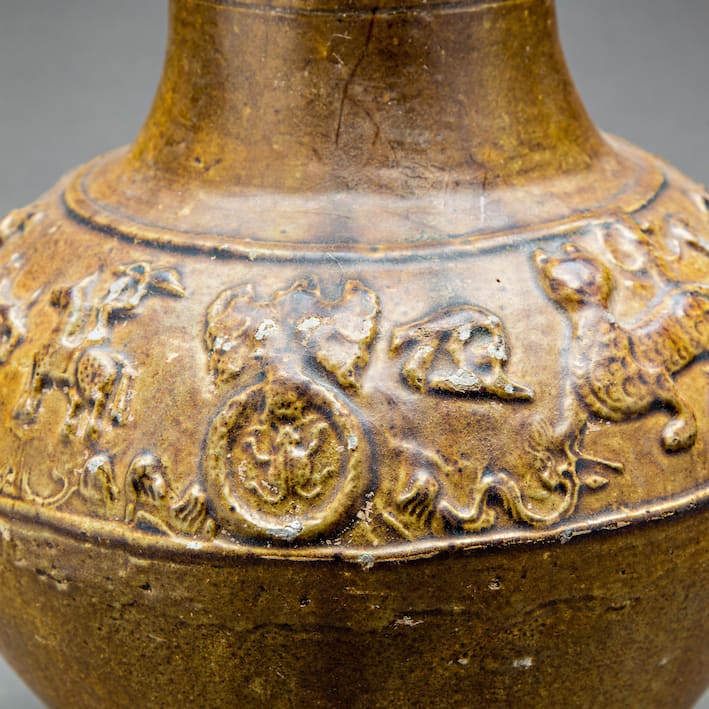Lead-Glazed Terracotta Jar, 100 BCE - 8 CE
buff earthenware
LO.617
Further images
Buff earthenware with moulded decoration and straw-coloured lead glaze. Similar in shape to contemporary bronze Hu vases , lead glazed ceramic versions emerged in Shaanxi during the second century BCE,...
Buff earthenware with moulded decoration and straw-coloured lead glaze.
Similar in shape to contemporary bronze Hu vases , lead glazed ceramic versions emerged in Shaanxi during the second century BCE, mostly to replace their metal prototype in tomb furnishings (mingqi). They were executed in diverse shapes, the most luxurious examples having moulded low-relief friezes.
The two animal masks with rings (pushou xianhuan) here serving as decorative handles, reflect the style of contemporary door-knockers.
The scene with various creatures could be interpreted as either a royal hunt or a depiction of the legendary Immortals land. In both cases a customary auspicious scene found on various media, from gilded boshanlu censers to lacquer and textiles.
Examples of this type of globular jar with flat bottom have been found in late Western Han tombs in Shaanxi and Henan, confirming the purpose of this type of ceramic ware.
Although a number of scholars have proposed that lead-flux glazes ultimately derived from the West, their emergence was probably encouraged by Chinese Daoist practice. In fact, Daoist alchemists in their search for immortality had since the Eastern Zhou period developed formulas involving the use of smelt lead which were believed to produce elixirs able to transform the body if swallowed.
The result of melting lead with sand and clay during the preparation of these immortality-granting potions were likely to have been noticed by the potters, who eventually adapted the process for glazing.
For comparable examples see:
Kaogu 1982.3: 226
Kaogu xuebao 1991r.2: 245-
Similar in shape to contemporary bronze Hu vases , lead glazed ceramic versions emerged in Shaanxi during the second century BCE, mostly to replace their metal prototype in tomb furnishings (mingqi). They were executed in diverse shapes, the most luxurious examples having moulded low-relief friezes.
The two animal masks with rings (pushou xianhuan) here serving as decorative handles, reflect the style of contemporary door-knockers.
The scene with various creatures could be interpreted as either a royal hunt or a depiction of the legendary Immortals land. In both cases a customary auspicious scene found on various media, from gilded boshanlu censers to lacquer and textiles.
Examples of this type of globular jar with flat bottom have been found in late Western Han tombs in Shaanxi and Henan, confirming the purpose of this type of ceramic ware.
Although a number of scholars have proposed that lead-flux glazes ultimately derived from the West, their emergence was probably encouraged by Chinese Daoist practice. In fact, Daoist alchemists in their search for immortality had since the Eastern Zhou period developed formulas involving the use of smelt lead which were believed to produce elixirs able to transform the body if swallowed.
The result of melting lead with sand and clay during the preparation of these immortality-granting potions were likely to have been noticed by the potters, who eventually adapted the process for glazing.
For comparable examples see:
Kaogu 1982.3: 226
Kaogu xuebao 1991r.2: 245-







